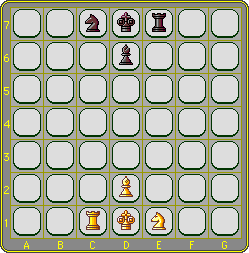The other two are Shakti and Caïssa.
Play Cyclix interactively or against an AI
Rules
In the initial position the board is covered with 49 tiles. There are two players, white and black. Each has a king, a rook, a bishop and a knight, initially positioned as shown.
 |
|
The pieces
- The king is an old acquaintance from Shakti: it moves to the first tile it can see in any of 8 directions. If in check, it is restricted to adjacent tiles.
If and when the king moves, the tile it vacates is either removed, or it sprouts a piece the player has 'in hand', see 're-entering'. - The rook moves and captures like a rook in chess.
- The bishop moves and captures like a bishop in chess.
- The knight moves and captures like a knight in chess.
Re-entering pieces
A 'piece in hand' may be optionally re-entered. This is done by moving the king and placing the piece on the tile thus vacated. If the king moves without re-entering a piece, then the tile it vacates is removed in the same turn. There are two conditions under either or both of which the king may not re-enter a piece:
- If the king makes a capture.
- If the king moves out of check.
Object
To checkmate the opponent's king.
Draws
Stalemate doesn't exist, 3-fold is a draw.
| How I invented ... Cyclix | ||||||||











